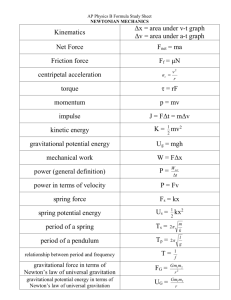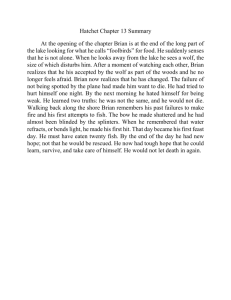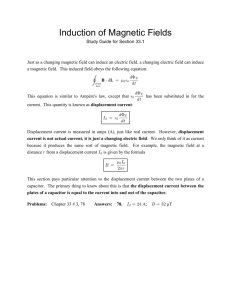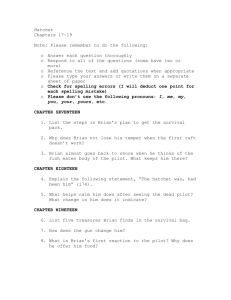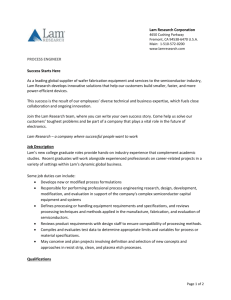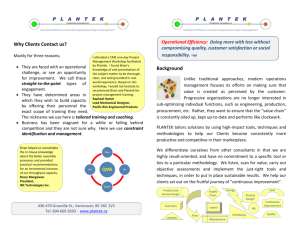02:36, 12 September 2011
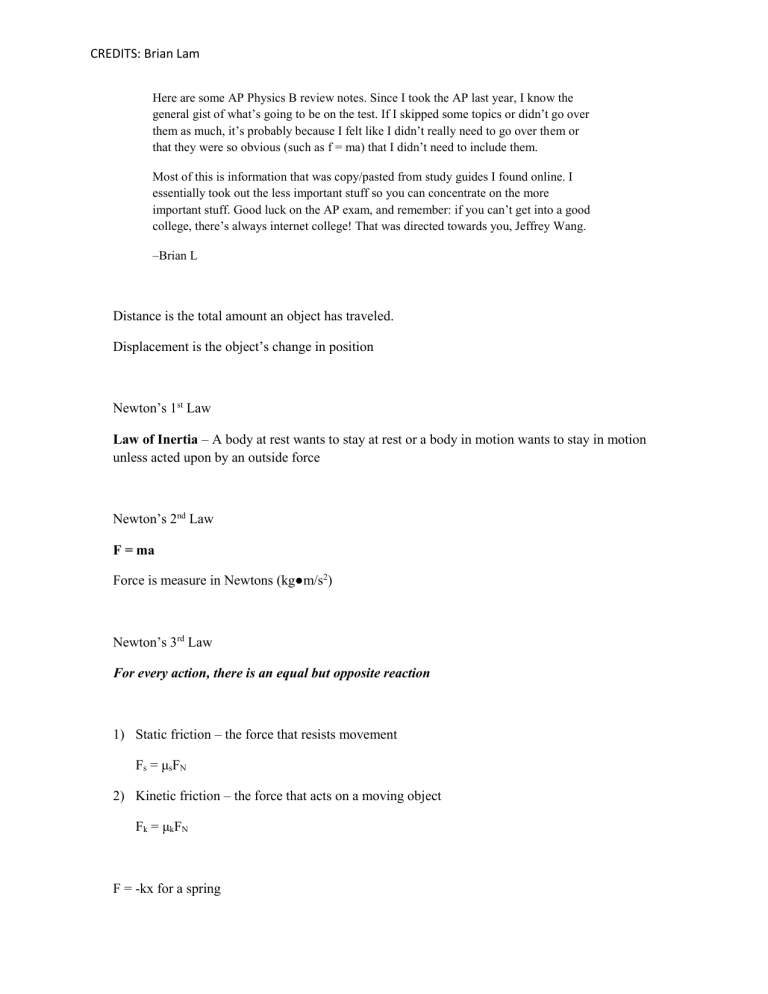
CREDITS: Brian Lam
Here are some AP Physics B review notes. Since I took the AP last year, I know the general gist of what’s going to be on the test. If I skipped some topics or didn’t go over them as much, it’s probably because I felt like I didn’t really need to go over them or that they were so obvious (such as f = ma) that I didn’t need to include them.
Most of this is information that was copy/pasted from study guides I found online. I essentially took out the less important stuff so you can concentrate on the more important stuff. Good luck on the AP exam, and remember: if you can’t get into a good college, there’s always internet college! That was directed towards you, Jeffrey Wang.
–Brian L
Distance is the total amount an object has traveled.
Displacement is the object’s change in position
Newton’s 1 st Law
Law of Inertia – A body at rest wants to stay at rest or a body in motion wants to stay in motion unless acted upon by an outside force
Newton’s 2 nd Law
F = ma
Force is measure in Newtons (kg●m/s 2 )
Newton’s 3 rd Law
For every action, there is an equal but opposite reaction
1) Static friction – the force that resists movement
F s
= μ s
F
N
2) Kinetic friction – the force that acts on a moving object
F k
= μ k
F
N
F = -kx for a spring
CREDITS: Brian Lam
In a spring, force and acceleration are greatest when displacement is greatest.
PE elastic
= ½ kx 2
PE is maximized when spring is at the endpoints, KE is minimum
PE is 0 when spring is passing through x=0 (equilibrium) and KE is maximum
T = 1/f
T = 2 ∏ √(m/k)
For pendulums:
2
T
g
L
F g
= pvg (remember you use the p of the liquid, not of what solid that’s in the liquid)
A
1 v
1
= A
2 v
2
P
1
+ pgy
1
+ ½ pv
1
2 = P
2
+ pgy
2
+ ½ pv
2
(notice the similarity to the conservation of energy equation. It should help you remember this)
Bernoulli effect: The pressure is lower where the flow speed is greater (airplanes, hurricanes).
Linear Thermal expansion:
L
L o
T
You shouldn’t have to worry about two or three dimensional thermal expansion for the AP.
Q
H
W
Q
C e
1
Q
C
Q
H
1
T
C
T
H
W
Q
H
Here’s an examplebecause the Q
H
and Q
C
variables can get confusing after a while.
A heat engine draws 800 J of heat from its high temperature source and discards 450 J of exhaust heat into its cold-temperature reservoir. How much work does this engine perform and what is its thermal efficiency? 350 J; 44%
An isobaric process is a process that occurs at constant pressure. The work is P ΔV
An isochoric process is a process that occurs at constant volume. NO WORK IS DONE.
An isothermal process is a process that occurs at constant temperature. The work is P ΔV
An adiabatic process is a process during which no energy is transferred to or from the system as heat
Pay especially close attention to adiabatic process!
CREDITS: Brian Lam
Coulomb’s law. Remember it’s r SQUARED, not just r. F
k q
1 r
2 q
2
Strength of an electric field created by a charge (again, remember the r SQUARED part):
E
k q r
2
Electric potential (Notice this is simply r and not r SQUARED):
V
kq r
It’s important to remember what is r SQUARED and what is just r. You will find a few questions that will ask you “if an object is distance r from an object, it experiences force of F. what force will it experience at a distance 2r?” And you’ll have to remember whether you use r 2 or r.
Capacitance: q = CV
Current, aside from being V/R, is also charge per time. I = q/t. Also, the direction of the current is taken to be the direction that a positive charge would move
F = qvB sin θ
Magnetic Force On a wire: F = LIB, or F = BIL, or F BIL (easier to remember if you know someone named Bill and you don’t like him).
Right hand rules:
Remember to reverse the direction of the force for a negatively charged particle!!!!!
CREDITS: Brian Lam n = c/v, NOT v/c. You can remember this because glass has a index of refraction greater than 1 and light travels slower in glass. Thus, if n were to equal v/c, glass’s index of refraction would be less than 1. f is
for a concave mirror.
f is
for a convex mirror.
d o is
if the object is in front of the mirror.
d i is
if the object is in front of the mirror (real image).
d o is
if m
the is
object is for an behind upright
the mirror.
object.
d i is
if the object is behind the mirror (virtual image).
m is
for an inverted object.
Converging lenses cause rays of light to converge to a focal point. Diverging lenses cause rays of light to diverge away from the focal point. That’s how you remember if a convex lens/concave lens/convex mirror/concave mirror is converging or diverging.
For satellites in orbit:
Maximum velocity for a car on a banked curve:
AP Physics B Study Sheet compiled by Brian L; information taken from multiple sources with comments made by him.
AP Physics B Formula Study Sheet
NEWTONIAN MECHANICS
Kinematics
Net Force
Friction force
Δx = area under v-t graph
Δv = area under a-t graph
F
F net f
= ma
= μF
N displacement is a change in position; velocity is the rate of change of displacement, acceleration is the rate of change of velocity the sum of all forces is proportional to mass x acceleration the friction force is proportional to the coefficient of friction x the normal force
CREDITS: Brian Lam centripetal acceleration torque momentum impulse kinetic energy gravitational potential energy mechanical work power (general definition) power in terms of velocity spring force spring potential energy period of a spring period of a pendulum relationship between period and frequency a c
v
2 r
τ = rF p = mv
J = FΔt = mΔv
1
K =
2 mv
2
U g
= mgh
W = FΔx
P =
W net
t
P = Fv
F s
= kΔx
1
U s
=
2 kΔx 2
T s
= 2
m k
T p
= 2
T = f
1 l g the acceleration of an object experiencing UCM is equal to the speed
2
/ the radius torque is equal to the perpendicular distance x the force momentum is equal to mass x velocity impulse is equal to the change in momentum kinetic energy is ½ mass x velocity 2 gravitational potential energy is mass x gravitational field x height work is the energy done by an external force moving through a displacement power is the rate of energy transfer power is the rate at which an external force moves through a displacement the force in a spring is equal to the spring constant x the amount of stretch or compression of the spring the energy stored in a spring = ½ x spring constant x the stretch or compression the period of a spring depends on mass and spring constant (not amplitude) the period of a pendulum depends on length and gravitational field period and frequency are reciprocals of each other
CREDITS: Brian Lam gravitational force between any two objects with mass gravitational potential energy between any two objects with mass
F
G
=
Gm
1 m
2 r
2
U
G
=
Gm
1 m
2 r any two masses exert a gravitational force on each other any 2-mass system near has potential energy
FLUID MECHANICS AND THERMAL PHYSICS absolute pressure in a fluid P = P
0
+ ρgh gage pressure
P = ρgh buoyant force F bouy
= ρVg fluid flow continuity A
1 v
1
= A
2 v
2 volume flow rate A
1 v
1
Bernoulli’s principle pressure (general definition)
P + ρgy +
1
2
ρv 2
= constant
P =
F
A ideal gas law PV = nRT = Nk
B
T internal energy in a gas velocity of a gas molecule thermal work v rms
3
K avg
=
2 k
B
T
=
3 RT
=
M
3 k
B
T
W = PΔV or area under graph change in internal energy ΔU = Q + W efficiency (general) e =
W net
Q in
CREDITS: Brian Lam ideal (Carnot) efficiency e c
=
T
H
T
H
T
C
ELECTRICITY AND MAGNETISM
Electrostatic force
Electrostatic field
Electrostatic potential energy
Electrostatic potential
Charge on a capacitor
Capacitance
Energy stored in a capacitor
Current (definition)
Resistance of a wire
Ohm’s Law
Power in a circuit
Equivalent resistor for series
Equivalent resistor for parallel
F e
= kq
1 q
2 r 2
E = kq
1 r
2
U e
= kq
1 q
2 r
V = kq
1 r
Q = VC
C =
0 d
A
U
C
= ½ QV = ½ CV
2
I =
Q
t
R =
l
A
V = IR
P = IV =
V
2
= I
2
R
R
R eq
= R
1
+ R
2
+ …
R eq
=
1
R
1
1
R
2
...
1
CREDITS: Brian Lam
Equivalent capacitance for series C eq
=
1
C
1
1
C
2
...
1
C eq
= C
1
+ C
2
+… Equivalent capacitance for parallel
Magnetic force on a moving charge in a magnetic field
Magnetic force on a current carrying wire in a magnetic field
Magnetic field around a current carrying wire
Magnetic flux
Average EMF generated by a changing magnetic field
EMF generated by a loop moving into or out of a magnetic field
F
B
= qvBsinθ
F
B
= BIlsinθ
B =
2
0
r
I
Φ m
= BAcosθ
ε avg =
m
t
ε = Blv
Good luck on the AP exam!
No, seriously, you’re gonna need it.
